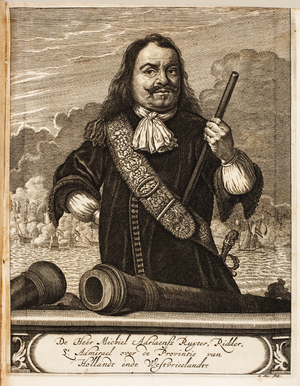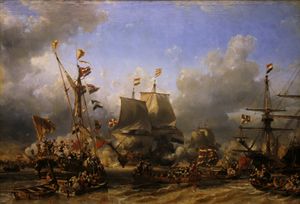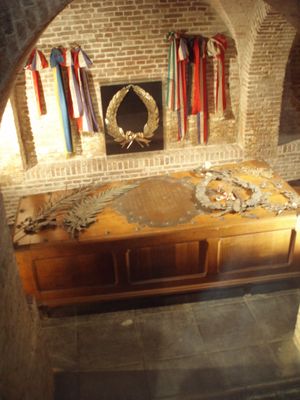ميخيل دى رويتر
| ميخيل دى رويتر | |
|---|---|
 Michiel de Ruyter painted by Ferdinand Bol in 1667 | |
| اسم الميلاد | Michiel Adriaenszoon |
| الكنية | Bestevaêr |
| وُلد | 24 مارس 1607 فلسنگن، زيلاند، الجمهورية الهولندية |
| توفى | 29 أبريل 1676 (aged 69) خليج سيراقوسة، بالقرب من صقلية |
| مكان الدفن | Nieuwe Kerk, أمستردام |
| الولاء | |
| سنوات الخدمة | 1637–1676 |
| معارك/حروب |
|
| جوائز | Order of St Michael |
ميخيل أدريانسون دى رويتر (Michiel Adriaenszoon de Ruyter ؛ النطق الهولندي: [mɪˈxil ˈaːdrijaːnˌsoːn də ˈrœy̯tər]؛ 24 مارس 1607 – 29 أبريل 1676) كان أميرال هولندي. He was one of the most skilled admirals in history، أهم ما اشتهر به كان دوره في الحروب الإنگليزية الهولندية of the 17th century. He fought the English and French and scored several major victories against them, the best known probably being the الغارة على المدواي. The pious De Ruyter was very much loved by his sailors and soldiers; from them his most significant nickname derived: Bestevaêr (في الهولندية القديمة تعني 'جـَد'.)
النشأة
وُلِد دى رويتر في 1607 في فلسنگن، بهولندا، ابناً لتباع الجعة أدريان ميخيلسون وآگيه يانزدوختر[1] Little is known about De Ruyter's early life, but he probably became a sailor at the age of 11. It is said that once, when he was a child, he climbed up ladders to get to the roof of his home town's church. Not knowing that De Ruyter was there, some workers then removed the ladders. De Ruyter had to smash the tiles on the church roof to get into the church and out the door. In 1622, he fought as a musketeer in the Dutch army under Maurice of Nassau against the Spaniards during the relief of Bergen-op-Zoom. That same year he rejoined the Dutch merchant fleet and steadily worked his way up. According to English sources, he was active in Dublin between 1623 and 1631 as an agent for the Vlissingen-based merchant house of the Lampsins brothers. Although Dutch sources have no data about his whereabouts in those years, it is known that De Ruyter spoke Irish fluently. He occasionally travelled as supercargo to the Mediterranean or the Barbary Coast. In those years, he usually referred to himself as "Machgyel Adriensoon", his name in the Zealandic dialect he spoke, not having yet adopted the name "De Ruyter". "De Ruyter" most probably was a nickname given to him. An explanation might be found in the meaning of the older Dutch verb ruyten or ruiten, which means "to raid", something De Ruyter was known to do as a privateer with the Lampsins ship Den Graeuwen Heynst.
الحرب الإنگليزية الهولندية الأولى

أثناء الحرب الإنگليزية الهولندية الأولى (1652–1654), De Ruyter was asked to join the expanding fleet as a subcommander of a Zealandic squadron of "director's ships": privately financed warships. After initially refusing,[2] De Ruyter proved his worth under supreme commander Lieutenant-Admiral (the nominal rank of Admiral-General was reserved for the stadtholder, but at the time none was appointed) Maarten Tromp, winning the Battle of Plymouth against Vice-Admiral George Ayscue. He also fought at the Battle of Kentish Knock and the Battle of the Gabbard. De Ruyter functioned as a squadron commander, being referred to as a commodore, which at the time was not an official rank in the Dutch navy.
Tromp's death during the Battle of Scheveningen ended the war, and De Ruyter declined an emphatic offer from Johan de Witt for supreme command because he considered himself 'unfit'[3] and also feared that it would bring him into conflict with Witte de With and Johan Evertsen, who had more seniority. Later, De Ruyter and De Witt became friends. Colonel Jacob van Wassenaer Obdam then became the new Dutch supreme commander of the confederate fleet. De Ruyter – after refusing to become Obdam's naval 'advisor'[4] – remained in the service of the Dutch navy, however, and later accepted an offer from the admiralty of Amsterdam to become their Vice-Admiral on 2 March 1654. He relocated with his family to the city in 1655.
1655–1663
In July 1655, De Ruyter took command of a squadron of eight (of which the Tijdverdrijf [Pastime] was his flagship) and set out for the Mediterranean with 55 merchantmen in convoy. His orders were to protect Dutch trade. Meeting an English fleet under Robert Blake along the way, he managed to avoid an incident. Operating off the Barbary Coast, he captured several infamous corsairs. After negotiating a peace agreement with Salé, De Ruyter returned home May 1656.
The same month, the States General, becoming ever more wary of Swedish King Charles X and his expansion plans, decided to intervene in the Northern Wars by sending a fleet to the Baltic Sea. The Swedes controlled this area after Charles had invaded Poland and made himself king there. De Ruyter once again embarked aboard the Tijdverdrijf, arriving at the Øresund 8 June; there he waited for Lieutenant-Admiral Jacob van Wassenaer Obdam to arrive. After Obdam had assumed command, De Ruyter and the Dutch fleet sailed to relieve the besieged city of Danzig/Gdańsk on 27 July, without any bloodshed. Peace was signed a month later. Before leaving the Baltic, De Ruyter and other flag officers were granted an audience by Frederick III of Denmark. De Ruyter took a liking to the Danish king, who later became a friend.
In 1658, the States General, on the advice of a leading member (Cornelis de Graeff, one of the mayors of Amsterdam), decided to once again send a fleet to the Baltic Sea to protect the important Baltic trade and to aid the Danes against Swedish aggression, which continued despite a peace settlement. In accordance with the States' balance-of-power political approach, a fleet under Lieutenant-Admiral Jacob van Wassenaer Obdam was sent, without De Ruyter, who at the time was blockading Lisbon. On 8 November, a bloody melee took place, the Battle of the Sound, which resulted in a Dutch victory, relieving Copenhagen. Still the Swedes were far from defeated and the States decided to continue their support. De Ruyter took command of a new expeditionary fleet and managed to liberate Nyborg in 1659. For this, he was knighted by King Frederick III of Denmark[5] From 1661 until 1663, de Ruyter did convoy duty in the Mediterranean.
الحرب الإنگليزية الهولندية الثانية

In 1664, a year before the الحرب الإنگليزية الهولندية الثانية officially began, De Ruyter clashed with the English off the West African coast, where the English and Dutch both had significant slave stations. He retook the Dutch possessions occupied by Robert Holmes and then crossed the Atlantic to raid the English colonies in North America.
Arriving off Barbados in the Caribbean at the end of April 1665 aboard his flagship Spiegel (Mirror), he led his fleet of thirteen vessels into Carlisle Bay, exchanging fire with the English batteries and destroying many of the vessels anchored there.[6] Unable to silence the English guns and having sustained considerable damage to his vessels, he retired to French Martinique for repairs.
Sailing north from Martinique, De Ruyter captured several English vessels and delivered supplies to the Dutch colony at Sint Eustatius. Given the damage he had sustained, he decided against an assault on New York (the former New Amsterdam) to retake New Netherland. He then took off to Newfoundland, capturing some English merchant ships and temporarily taking St. John's[7] before proceeding to Europe.
On his return to the Netherlands, De Ruyter learned that van Wassenaer had been killed in the disastrous Battle of Lowestoft. Many expected Tromp's son Cornelis to take command of the confederate fleet, especially Cornelis Tromp himself, who had already been given a temporary commission.[8] However, Tromp was not acceptable to the regent regime of Johan de Witt because of his support for the Prince of Orange's cause. De Ruyter's popularity had grown after his heroic return and, most importantly, his affiliation lay with the States General and Johan de Witt in particular. He therefore was made commander of the Dutch fleet on 11 August 1665, as Lieutenant-Admiral (a rank he at the time shared with six others) of the Amsterdam admiralty.
In this Second Anglo-Dutch War (1665–1667), he won the hard-fought Four Days Battle in June 1666, but narrowly escaped disaster in the St James's Day Battle in August, which brought him into conflict with Cornelis Tromp, eventually leading to Tromp's dismissal. He then became seriously ill, recovering just in time to take nominal command of the fleet executing the Raid on the Medway in 1667. The Medway raid was a costly and embarrassing defeat for the English, resulting in the loss of the English flagship HMS Royal Charles and bringing the Dutch close to London. A planned Dutch attack on the English anchorage at Harwich led by De Ruyter had to be abandoned after being repelled at Landguard Fort at the close of the war. The Peace of Breda brought the war to an end.
Between 1667 and 1671, he was forbidden by De Witt to sail, in order not to endanger his life.[9] In 1669, a failed attempt on his life was made by a Tromp supporter, who tried to stab him with a bread knife in the entrance hall of his house.[10]
الحرب الإنگليزية الهولندية الثالثة ووفاته

De Ruyter saved the situation for the Netherlands in the الحرب الإنگليزية الهولندية الثالثة. His strategic victories over larger Anglo-French fleets at the Battles of Solebay (1672), the double Schooneveld (1673) and Texel (1673) warded off invasion. The new rank of Lieutenant-Admiral-General was created especially for him in February 1673, when the new stadtholder William III of Orange became Admiral-General.
Again taking the fight to the Caribbean, this time against the French, De Ruyter arrived off Martinique aboard his flagship De Zeven Provinciën on 19 July 1674. He led a substantial force of eighteen warships, nine storeships, and fifteen troop transports bearing 3,400 soldiers. When attempting to assault Fort Royal, his fleet was becalmed, allowing the greatly outnumbered French defenders time to solidify their defenses. The next day, newly placed booms prevented De Ruyter from entering the harbor. Nonetheless, the Dutch soldiers went ashore without the support of the fleet's guns, and were severely mauled in their attempt to reach the French fortifications atop the steep cliffs. Within two hours, the soldiers returned to the fleet with 143 killed and 318 wounded, compared to only 15 French defenders lost. His ambitions thwarted and with the element of surprise lost, De Ruyter sailed north to Dominica and Nevis, then returned to Europe while disease spread aboard his ships.
In 1676, he took command of a combined Dutch-Spanish fleet to help the Spanish suppress the Messina Revolt and fought a French fleet, under Duquesne, at the Battle of Stromboli and the Battle of Augusta, where he was fatally wounded when a cannonball struck him in the right leg. On 18 March 1677, De Ruyter was given an elaborate state funeral. His body was buried in the Nieuwe Kerk (New Church) in Amsterdam. He was succeeded as supreme commander by Cornelis Tromp in 1679.
ذكراه

De Ruyter was highly respected by his sailors and soldiers, who used the term of endearment Bestevaêr ("Granddad") for him, both because of his disregard for hierarchy (he was himself of humble origin) and his refusal to turn away from risky and bold undertakings, despite his usually cautious nature.
He is honoured by a statue in his birthplace Vlissingen which stands looking over the sea. Multiple towns in the Netherlands have a street named after him.
Respect also extended far beyond the borders of the Republic. On his last journey home, the late Lieutenant-Admiral-General was saluted by cannon shots fired on the coasts of France by the direct orders of the French King Louis XIV. The town of Debrecen erected a statue of him for his role in freeing 26 Protestant Hungarian ministers from slavery.
Six ships of the Royal Netherlands Navy have been named HNLMS De Ruyter and seven are named after his flagship HNLMS De Zeven Provinciën.
Michiel de Ruyter was involved in the founding of the Dutch Marine Corps (established 10 December 1665). The new base for the Dutch Marine Corps, which will be built in De Ruyter's birthplace of Flushing and should be finished by 2020, will be called the "Michiel de Ruyter kazerne".
De Ruyter's descendants live in the United States, Belgium, Britain, South Africa, Australia, New Zealand and Canada.[بحاجة لمصدر]
إشارات حديثة

- In the 2004 election of De Grootste Nederlander (The Greatest Dutchman), Michiel de Ruyter was the seventh-most voted.
- 'Michiel de Ruyter' is the default name for the Dutch in Sid Meier's 1994 game Colonization.
- De Ruyter's burial site has now turned into a tourist attraction. His mausoleum is visible, protected by a glass pane. However, descendants of the De Ruyter family are granted unrestricted access to his grave, and one of De Ruyter's descendants stated in a 2007 issue of the Dutch newspaper Het Parool that he visited the coffin privately in 1948 with his own grandfather. They decided to lift the coffin's lid. The grandson reported being shocked with the sight and said: "it wasn't a pleasant sight. He (De Ruyter) was embalmed with great haste, and they didn't bother with his shot-off leg, they just dropped it in. It was just lying there. No, it wasn't pleasant, it was a shock actually."
- The small town and village of DeRuyter, New York, southeast of Syracuse, are named after the admiral.[11]
- In the book Captain Blood: his Odyssey by Rafael Sabatini, the title character serves in the Dutch Navy under De Ruyter.
- Negyven prédikátor, a 1973 novel written by György Moldova[مطلوب توضيح]
- Mentioned in the 2015 music album The Diary of the Dutch metal band The Gentle Storm.
- Michiel de Ruyter, a 2015 film directed by Roel Reiné.[12] The film was released to English-speaking audiences as "Admiral."
الهامش
- ^ Prud’homme , 1996, p. 19
- ^ Prud’homme , 1996, p. 59
- ^ Prud’homme , 1996, p. 85
- ^ Prud’homme , 1996, p. 86
- ^ Prud’homme , 1996, p. 114
- ^ Staff writer (n.d.). "History: History and Development > SETTLEMENT OF BRIDGETOWN". Barbados' UNESCO World Heritage application. The Ministry of Community Development & Culture, Barbados. Archived from the original on 7 يوليو 2011. Retrieved 17 مارس 2011.
In 1665, the Charles Fort played a major role in successfully defending Barbados from attack by the Dutch (commanded by Admiral Michel De Ruyter) who had attempted a surprise assault from the east.
{{cite web}}: Cite has empty unknown parameters:|separator=,|month=, and|coauthors=(help); Unknown parameter|deadurl=ignored (|url-status=suggested) (help) - ^ Staff writer (n.d.). "History of St. john's".
{{cite web}}: Cite has empty unknown parameters:|month=,|separator=, and|coauthors=(help) - ^ Prud’homme , 1996, p. 152
- ^ Prud’homme , 1996, p. 228
- ^ Prud’homme , 1996, p. 253
- ^ Gannett, Henry (1905). The Origin of Certain Place Names in the United States. Govt. Print. Off. p. 104.
- ^ (هولندية) Game of Thrones-acteur Dance in Michiel de Ruyter, Nu.nl, 5 June 2014
Literature
- Bruijn, Jaap R.; Prud'homme van Reine, Ronald; Van Hövell tot Westerflier, Rolof (2011). De Ruyter, Dutch Admiral. Rotterdam: Karwansaray Publishers. ISBN 978-94-90258-03-0.
- Hainsworth, D. Roger; Churches, Christine (1998). The Anglo-Dutch Naval Wars 1652-1674. Sutton Publishing Ltd. ISBN 978-0750917872.
- Hellinga, Gerben Graddesz (2006). Zeehelden van de Gouden Eeuw. Zutphen: Walburg Pers. ISBN 978-9057305467.
- Hellinga, Gerben Graddesz (2007). Geschiedenis van Nederland: De Canon van ons Vaderlands Verleden. Zutphen: Walburg Pers. ISBN 978-9057306006.
- Warner, Oliver (1973). Great Sea Battles. London: Spring Books. ISBN 978-0896731004.
- Warnsinck, Johan Carel Marinus (1941). Twaalf doorluchtige zeehelden. Amsterdam: P. N. van Kampen & Zoon.
- Warnsinck, Johan Carel Marinus (1941). Van vlootvoogden en zeeslagen. Amsterdam: P. N. van Kampen & Zoon.
وصلات خارجية
- (هولندية) Michiel de Ruyter Foundation
| مناصب عسكرية | ||
|---|---|---|
| سبقه Jacob van Wassenaer Obdam |
Supreme Commander of the Dutch Navy | تبعه Cornelis Tromp |
- CS1 errors: unsupported parameter
- Articles with unsourced statements from June 2016
- جميع الصفحات التي تحتاج تنظيف
- مقالات بالمعرفة تحتاج توضيح from March 2016
- مواليد 1607
- وفيات 1676
- 17th-century Dutch military personnel
- Admirals of the navy of the Dutch Republic
- Burials at the Nieuwe Kerk (Amsterdam)
- Danish nobility
- Dutch naval personnel of the Anglo-Dutch Wars
- Dutch military personnel killed in action
- Dutch people of the Eighty Years' War (United Provinces)
- Knights of the Order of Saint Michael
- People from Vlissingen
- Whalers
- Whaling in the Netherlands


